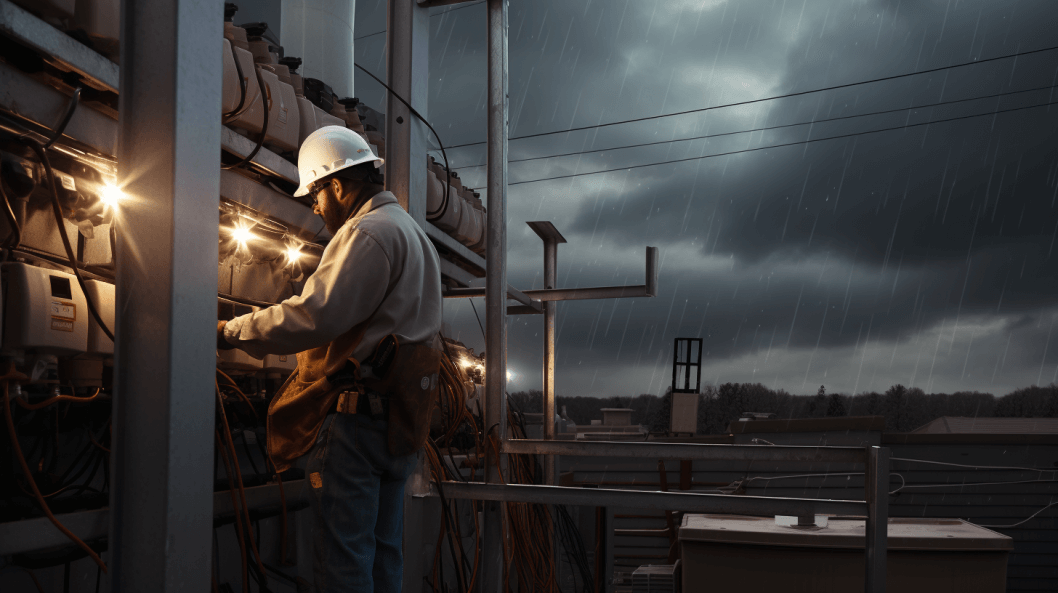This article provides a focused and analytical examination of the NFPA 780 risk assessment standard. NFPA 780 is a widely recognized standard with guidelines for assessing lightning risks in various structures.
The objective is to delve into the details and intricacies of NFPA 780, offering a comprehensive understanding of its significance and implications.

NFPA 780 Risk Assessment
The NFPA 780 is a standard developed by the National Fire Protection Association that provides guidelines for installing and maintaining lightning protection systems.
It is important to conduct a risk assessment based on NFPA 780 to ensure the safety of structures and individuals.
One key aspect of the risk assessment is determining the average lightning flash density in a specific area, which helps determine the level of protection required.
Lightning risk assessments are crucial in determining a building or structure’s potential dangers and vulnerabilities from lightning strikes. These assessments involve evaluating various factors such as the building’s location, size, height, and the presence of nearby structures.
Experts in lightning risk assessment use meticulous calculations and analysis to determine the risk level and develop appropriate lightning protection measures.
Insurance claims for lightning-related damages are expected, highlighting the need for effective lightning protection systems.
Lightning surges can cause severe damage to buildings and electrical equipment and even result in fires. Therefore, it is essential to have an approach to lightning protection that complies with standards such as IEC-62305-2.
Lightning protection systems, including catenary lightning protection systems, are designed to minimize the consequences of lightning strikes.
These systems provide a path for the lightning discharge to safely reach the ground, reducing the risk of damage to the building and its occupants.
Lightning protection companies offer services such as lightning risk assessments, optimal design of lightning protection systems, and installation of lightning protection components.
In addition to the physical damages caused by lightning strikes, there are potential dangers associated with electrical hazards and the impact on critical infrastructure. Lightning-induced hazards can lead to a breakdown in conductors, contact voltage, and harm to lives.
This is particularly crucial in aerospace and critical infrastructure industries, where equipment protection and continuity of services are of utmost importance.
Decades of lightning monitoring and analysis have allowed experts to determine the frequency and distribution of lightning strikes in different regions.
By evaluating factors such as flash density, building owners can make informed decisions about the level of lightning protection required for their structures.
Lightning risk assessments provide valuable insights into the potential risks and vulnerabilities associated with lightning strikes, enabling proactive measures to minimize damages and ensure people’s and property’s safety.
Additionally, the type of structure and the selection of air terminals play a crucial role in mitigating the risk of lightning strikes.
Failure to comply with NFPA 780 guidelines can result in significant loss of life and a heightened risk of panic among occupants of the structure.
Overview of NFPA 780
NFPA 780 is a standard developed by the National Fire Protection Association that focuses on structure lightning protection.
It provides guidelines for designing, installing, inspecting, and maintaining lightning protection systems.
The standard emphasizes the importance of conducting a thorough lightning risk assessment to determine the level of protection needed.
This assessment considers factors such as the lightning exposure of the structure, the lightning flash frequency in the area, and the potential for lightning damage.
By following NFPA 780’s guidelines, engineers and designers can ensure that lightning protection systems are effectively implemented to mitigate the risks associated with lightning strikes and reduce the potential for damage.
Importance of NFPA 780 Risk Assessment
One essential aspect of NFPA 780 is the thorough evaluation of lightning hazards, which is vital in determining the appropriate level of protection necessary for structures.
The importance of NFPA 780 risk assessment lies in the fact that it provides a comprehensive framework for lightning risk analysis and assessment.
By following the lightning risk assessment standards outlined in NFPA 780, lightning risk analysis experts can identify potential vulnerabilities and recommend appropriate lightning protection measures.
These measures include the optimal design of lightning protection systems and the selection of suitable lightning protection components.
Conducting lightning risk assessments in accordance with NFPA 780 ensures that structures are adequately protected against the damaging effects of lightning strikes.
Therefore, adherence to NFPA 780 risk assessment guidelines is crucial to safeguarding structures and minimizing the potential for lightning-related incidents.
Average Lightning Flash Density
Average lightning flash density can provide valuable information about the frequency and distribution of lightning activity in a given area.
When conducting a lightning risk assessment, the calculation of average lightning flash density is an essential component.
The NFPA and other lightning protection standards recognize this parameter as a crucial factor in assessing lightning risk.
This measurement allows for a detailed understanding of the potential exposure to lightning strikes in a particular location.
By incorporating average lightning flash density into the risk assessment, lightning experts can identify areas with higher lightning risk and develop appropriate mitigation strategies.
It is important to note that determining average lightning flash density requires meticulous data collection and analysis.
Therefore, accurate and reliable measurements are necessary to ensure the validity of the lightning risk assessment.
Type of Structure and Air Terminals
The type of structure and the installation of air terminals are important factors to consider when evaluating lightning protection.
The design and construction of buildings play a crucial role in determining their vulnerability to lightning strikes.
Factors such as the height, shape, and materials used in the structure can influence the likelihood of lightning strikes.
Additionally, the presence of air terminals, also known as lightning rods, can provide a path for lightning to follow and reduce the risk of damage to the building.
To ensure effective lightning protection, it is essential to assess the specific hazards faced by a facility and tailor the lightning protection system accordingly.
This includes considering the potential impact on human lives and the valuable assets within the structure.
By carefully evaluating the type of structure and installing appropriate air terminals, the risks associated with lightning strikes can be minimized, ensuring the safety and security of the facility.
Loss of Life and Risk of Panic
Loss of life and potential panic are significant concerns when evaluating the impact of lightning strikes on a facility and its occupants.
Conducting a thorough risk assessment is crucial to identify vulnerabilities and implement appropriate lightning protection measures.
Lightning risk assessments should be conducted by experienced lightning protection experts with extensive lightning testing experience. They analyze the type of structure and air terminals, ensuring compliance with building codes and industry standards.
Facility managers of critical facilities must prioritize lightning protection to minimize the risk of loss of life and panic among occupants.
Adequate lightning protection systems, such as lightning strike roofs, can help dissipate the electrical discharge safely, preventing potential injuries or casualties.
By incorporating comprehensive risk assessment processes, the potential for loss of life and risk of panic can be effectively mitigated.
Lightning Protection Systems
Lightning protection systems are crucial in mitigating the potential harm caused by lightning strikes on facilities and their occupants.
According to the NFPA 780 risk assessment guidelines, lightning risk assessments should be conducted to identify vulnerabilities and determine appropriate protective measures.
These systems are designed to intercept lightning strikes and safely conduct the electrical current to the ground, preventing damage to the structure and reducing the risk of fire or explosion.
Lightning rods, also known as air terminals, are typically installed on the highest points of a building to attract lightning strikes and provide a path for electrical discharge.
Additionally, these systems should include surge protection devices to safeguard electronic equipment from power surges caused by lightning events.
It is essential to consult a qualified lightning system designer to ensure the effectiveness and compliance of the lightning protection system.
Frequency of Lightning Strikes & Lightning Exposure
Lightning strikes occur with varying frequencies depending on the geographical location and climatic conditions.
Conducting lightning risk assessments is crucial for determining the need for lightning protection systems in a particular area.
These assessments involve analyzing the frequency of lightning strikes and the resulting lightning exposure. Lightning risk assessments consider factors such as lightning damaging potential, lightning, and lightning strike density.
Lightning flash density maps often identify areas with higher lightning exposure.
By understanding the frequency of lightning strikes and the associated risks, appropriate measures can be taken to mitigate the potential damage caused by lightning.
This includes the installation of lightning protection systems and the implementation of safety protocols to reduce the risks and ensure the safety of people and property in lightning-prone areas.
Lightning Strike Damages
The damages caused by lightning strikes can vary greatly depending on factors such as the location of the strike, the type of structure affected, and the intensity of the lightning bolt.
Lightning risk assessments play a crucial role in identifying vulnerabilities to lightning strikes and determining the necessary lightning protection measures.
Damages from lightning can range from minor to severe, including structural damage, electrical system failures, and fire outbreaks.
Lightning strikes can cause significant damage to buildings, infrastructure, and equipment, leading to financial losses and potential safety hazards.
Lightning protection systems, such as lightning rods and surge protectors, are designed to mitigate the potential damages caused by lightning discharge.
Ground flash density and ground potential are important factors to consider in assessing the risk of lightning strikes and their associated damages.
Understanding and addressing electrical storm hazards is essential in minimizing the risks and damages associated with lightning strikes.
Lightning Flash Frequency & Testing Experience
The frequency of lightning flashes and testing experience are important factors to consider in evaluating the effectiveness of lightning protection systems.
- Conductors: Lightning protection systems rely on conductive materials to safely channel the electrical energy from lightning strikes. The frequency of lightning flashes can determine the conductors required to dissipate the energy effectively.
- Lightning risk assessments: Testing experience is crucial in identifying potential hazards and vulnerabilities in a building’s lightning protection system. Regular testing can help ensure the system functions properly and provides adequate protection.
- Overview of lightning protection: Understanding the frequency of lightning flashes and having testing experience gives building managers and owners a comprehensive overview of lightning protection. This knowledge is essential for making informed decisions regarding installing and maintaining lightning protection systems.
Analyzing the frequency of lightning flashes and gaining testing experience is particularly important for isolated buildings, as they often lack the infrastructure and resources to withstand lightning strikes.
Furthermore, cultural heritage sites and buildings housing valuable electronic equipment require thorough risk assessments to prevent damage and preserve important artifacts or data.

Overview of Lightning Protection Measures
One important aspect to consider when evaluating the effectiveness of lightning protection systems is the implementation of various measures to mitigate the potential damage caused by electrical discharges.
Lightning protection system installation requirements play a crucial role in determining the level of protection provided.
These requirements include properly using grounding techniques, such as installing ground rods, to dissipate the lightning’s energy into the ground safely.
Additionally, the system should be designed to handle the high voltage and transient voltage surge protection that comes with lightning strikes.
Insulation breakdowns are a common cause of damage, so effective lightning protection systems should include measures to prevent this, such as using surge protection devices and ensuring proper insulation for electrical equipment.
A comprehensive understanding of the requirements and processes involved in lightning risk assessments is essential for designing and implementing effective lightning protection systems.
Lightning Protection Experts and Risk Assessments
Lightning protection experts are crucial in conducting thorough evaluations and analyses to determine the risk associated with lightning strikes and develop effective protection strategies.
These experts specialize in conducting detailed lightning risk assessments for various structures, including commercial buildings, historical buildings, and other facilities.
They assess the hazards of lightning by considering factors such as the structure’s location, height, materials, and the presence of flammable materials.
By working closely with facility owners, these experts ensure compliance with building codes and develop comprehensive facility protection systems.
Their expertise and knowledge enable them to identify potential vulnerabilities and recommend appropriate lightning protection measures, such as lightning rods, surge protection devices, and grounding systems.
Through their assessments, lightning protection experts help minimize the risk of property damage, injury, and downtime caused by lightning strikes.
Maintaining a High Level of Protection – Professional Services Needed
To ensure ongoing protection against lightning strikes, it is imperative to engage the services of qualified professionals who possess the expertise and knowledge required for maintaining a high level of protection.
These professionals play a crucial role in maintaining high-level protection by conducting regular lightning risk assessments and implementing necessary measures.
They are well-versed in the lightning protection standards set forth by organizations like the National Fire Protection Association (NFPA 780), ensuring that the facility’s protection systems are up to date and in compliance with the latest guidelines.
Additionally, these experts deeply understand lightning conduct and can assess the potential damage that lightning strikes can cause.
By utilizing their services, facility owners can be confident that their protection systems are optimized based on factors such as the facility’s location and the ground flash density map in the area.
A Comprehensive Approach to Risk Analysis & Assessment Capabilities
To maintain a high level of protection against lightning strikes, it is crucial to have access to professional services that specialize in the comprehensive analysis and assessment of lightning risks.
These services provide a systematic approach to evaluating the potential danger of lightning strikes and determining the appropriate measures to mitigate these risks.
Grounded in rigorous research and expertise, these professionals conduct lightning risk assessments that consider building dimensions, annual lightning strikes in the area, and the consequences of lightning strikes on the structure and its occupants.
Their thorough approach ensures that installing lightning protection systems meets the highest standards and serves as a benchmark in lightning risk management.
Additionally, certification in lightning protection confirms the expertise of these professionals, making them reliable experts in safeguarding structures from the destructive power of lightning.
Frequently Asked Questions
What are the common methods used for conducting a risk assessment according to NFPA 780?
Common risk assessment methods include identifying potential hazards, assessing their likelihood and impact, determining risk levels, and implementing mitigation measures.
These methods provide a systematic approach to evaluating and managing risks in accordance with NFPA 780 guidelines.
Are there any specific guidelines provided by NFPA 780 for determining the severity of lightning risk?
NFPA 780 provides specific guidelines for determining the severity of lightning risk. These guidelines consider factors such as the frequency of lightning strikes, the susceptibility of the structure to damage, and the potential consequences of a lightning strike.
How does NFPA 780 recommend addressing the risk of lightning strikes for structures located in high-risk areas?
NFPA 780 recommends addressing the risk of lightning strikes for structures in high-risk areas by implementing a comprehensive lightning protection system.
This system should include air terminals, conductors, grounding, and surge protection devices to minimize the potential damage caused by lightning strikes.
Is there a specific timeframe recommended by NFPA 780 for conducting regular risk assessments?
NFPA 780 does not specify a specific timeframe for conducting regular risk assessments. However, it is generally recommended to conduct risk assessments periodically to ensure that the lightning protection system remains effective and up-to-date.
Are there any industry-specific requirements or considerations that NFPA 780 suggests incorporating into the risk assessment process?
Industry-specific requirements and considerations suggested by NFPA 780 for risk assessment include evaluating lightning protection systems, assessing the potential impact on critical operations, considering the specific characteristics of the facility, and determining the acceptable level of risk tolerance.

Conclusion
The NFPA 780 risk assessment is a crucial tool for evaluating potential hazards and implementing effective measures for lightning protection.
This assessment provides a comprehensive understanding of the risks involved by assessing various factors, such as the frequency and severity of lightning strikes, the vulnerability of structures and their contents, and the effectiveness of existing protection systems.
This detailed analysis allows for identifying necessary improvements and implementing appropriate safeguards to mitigate the potential impact of lightning strikes.
In conclusion, the NFPA 780 risk assessment is essential in ensuring the safety and protection of structures and their occupants.

Chris Ekai is a Risk Management expert with over 10 years of experience in the field. He has a Master’s(MSc) degree in Risk Management from University of Portsmouth and is a CPA and Finance professional. He currently works as a Content Manager at Risk Publishing, writing about Enterprise Risk Management, Business Continuity Management and Project Management.

